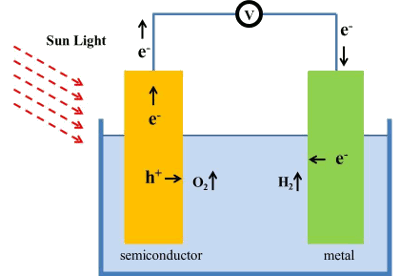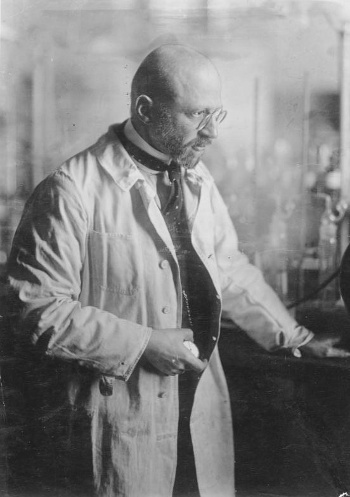Water Photolysis by Antimony-Doped Gallium Nitride
September 1, 2011
I reviewed the
photolysis of
water (
splitting water into
hydrogen and
oxygen using light energy) in two previous articles,
Manganese Photolysis of Water (June 1, 2011) and
Titania Photocatalysis (February 16, 2011). This would be one method of using solar energy to provide
vehicular fuel. The other, of course, is
photovoltaics for
generating electricity.
Research in water-splitting using light accelerated after the 1972 publication of an article in
Nature by Akira Fujishima and Kenichi Honda.[1] They described a
photoelectrochemical cell that used
titania as a
photoanode.[1-2] This cell was capable of water photolysis.
One problem with the Fujishima-Honda photolysis cell is that it was
inefficient in conversion of
solar energy into hydrogen. Since titania, in its
rutile crystal form, has a
bandgap of 3.0
eV, it will only split water when illuminated by light shorter in
wavelength than 413.75
nm. Less than 10% of solar energy appears in those wavelengths. Others have been researching ways to reduce the titania bandgap to increase efficiency.[3-4]
I reviewed
gallium nitride (GaN), an important
semiconductor material for high speed and high power electronics, in a
previous article (Gallium Nitride Crystals, July 29, 2010). Since gallium nitride in its
zinc blende crystal structure has a bandgap of 3.2 eV, which is higher than titania, you wouldn't expect it to be a candidate as a photolysis material. Also, two-inch diameter
single crystal wafers of GaN are priced at about a thousand dollars, although
one company is working on a process to make less expensive GaN wafers.
A recent paper in
Physical Review B by a broadly-based research team with members at the
University of Kentucky (Lexington, Kentucky),
Daimler AG GR/PSS (Ulm, Germany), the
Greek Foundation for Research and Technology, FORTH (Heraklio, Crete, Greece), the
University of South Florida (Tampa, Florida) and the
University of Louisville (Louisville, Kentucky) looks at the consequences of doping gallium nitride with
antimony (Sb).[5-6]
They found that a 2% doping of Sb in GaN will significantly reduce its band gap. Since GaN is a high temperature semiconductor, there's a possibly for efficient operation in
solar concentrator arrays. Unfortunately, this is a
computation and not an
experiment, so I'll reserve judgment until I see
the real thing.

Water photolysis using Sb-doped gallium nitride.
(Image via University of Kentucky))
The Sb-GaN team used a first-principles
density functional theory based on the
Hubbard Model, a conventional starting place for semiconductor calculations. The Hubbard model uses a
Hamiltonian that includes a term for
electron hopping between sites and another for the
potential energy of the electron while on site. In their model, they used a local density approximation and a generalized gradient approximation to refine the calculations.[6]
The calculations indicate that antimony in small concentrations will significantly narrow the band gap of gallium nitride to 2 eV, equivalent to a wavelength of 620 nm, thus allowing a greater fraction of sunlight to be harvested for hydrogen production. The authors state that Sb-GaN would be easy to produce and inexpensive.
If we consider
ceramic, rather than single crystal, material, "inexpensive" is still a relative term.
Gallium now sells for about $500,000 per
metric ton, or fifty cents per
gram.[7] As a reference value,
iron sells for about $400 per ton. Photolysis of water with iron? Materials scientists take note, that's a worthy stretch goal! You have the example of
Fritz Haber, who used iron as a
catalyst to make
ammonia.

Fritz Haber, 1905.
Haber's discovery of a cataytic process for the production of ammonia earned him a Nobel Prize in Chemistry (1918).
His work also generated some controversy.
(Deutsches Bundesarchiv (German Federal Archive), Photograph No. 183-S13651, via Wikimedia Commons))
![]()
References:
- Akira Fujishima and Kenichi Honda, "Electrochemical Photolysis of Water at a Semiconductor Electrode," Nature, vol. 238, no. 5358 (July 7, 1972), pp. 37-38.
- J. Keeney, D. H. Weinstein and G. M. Haas, "Electricity from photosensitisation of titanium," Nature, vol. 253, no. 5494 (February 27, 1975), pp. 719-720.
- Dan Krotz, "A Dash of Disorder Yields a Very Efficient Photocatalyst," Lawrence Berkeley Laboratory Press Release, January 28, 2011.
- Xiaobo Chen, Lei Liu, Peter Y. Yu and Samuel S. Mao, "Increasing Solar Absorption for Photocatalysis with Black Hydrogenated Titanium Dioxide Nanocrystals," Science, vol. 331, no. 6018 (February 11, 2011), pp.746-750.
- Keith Hautala, "Novel Alloy Could Produce Hydrogen Fuel from Sunlight," University of Kentucky Press Release, Aug 31, 2011.
- R. Michael Sheetz, Ernst Richter, Antonis N. Andriotis, Sergey Lisenkov, Chandrashekhar Pendyala, Mahendra K. Sunkara and Madhu Menon, "Visible-light absorption and large band-gap bowing of GaN1−xSbx from first principles," Phys. Rev. B, vol. 84, no. 7 (August, 15 2011), Document No. 075304 (4 pages).
- Gallium Statistics, U.S. Geological Survey, October 5, 2010
Permanent Link to this article
Linked Keywords: Photolysis; water; splitting water; hydrogen; oxygen; Manganese Photolysis of Water; Titania Photocatalysis; hydrogen economy; vehicular fuel; photovoltaics; electricity generation; Nature; photoelectrochemical cell; titania; photoanode; energy conversion efficiency; solar energy; rutile; bandgap; band gap; eV; wavelength; nm; gallium nitride; semiconductor; zinc blende crystal structure; single crystal wafer; www.ammono.com; Physical Review B; University of Kentucky (Lexington, Kentucky); Daimler AG GR/PSS (Ulm, Germany); Greek Foundation for Research and Technology, FORTH (Heraklio, Crete, Greece); University of South Florida (Tampa, Florida); University of Louisville (Louisville, Kentucky); antimony; solar concentrator; computer simulation; computation; experiment; Ain't Nothing Like the Real Thing; density functional theory; Hubbard Model; Hamiltonian; electron; potential energy; ceramic; gallium; metric ton; gram; iron; Fritz Haber; catalyst; ammonia; Haber process; Nobel Prize in Chemistry; Fritz Haber Criticism; Wikimedia Commons.